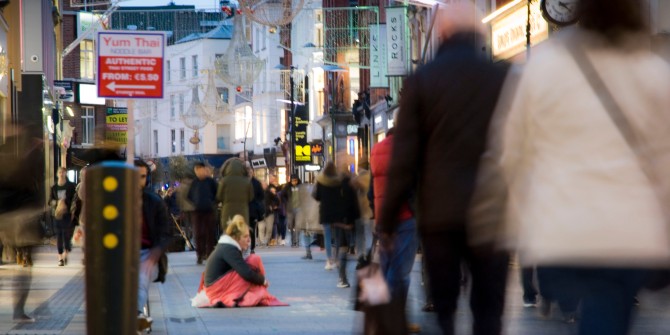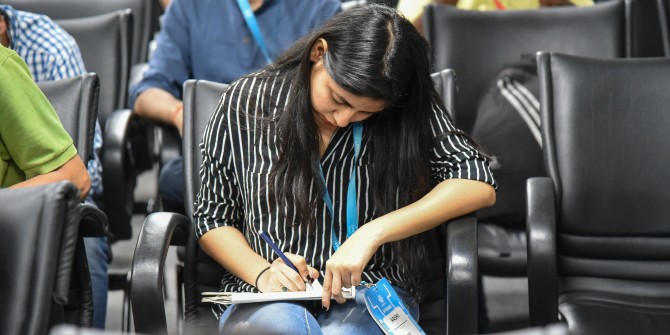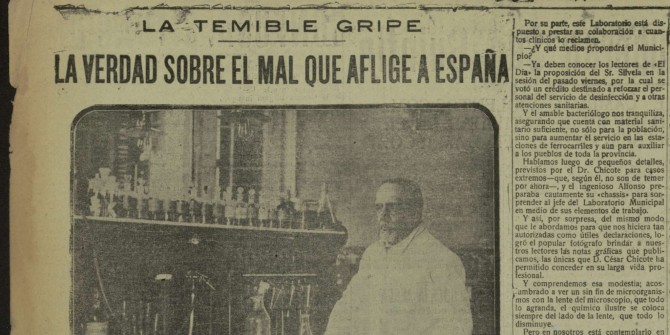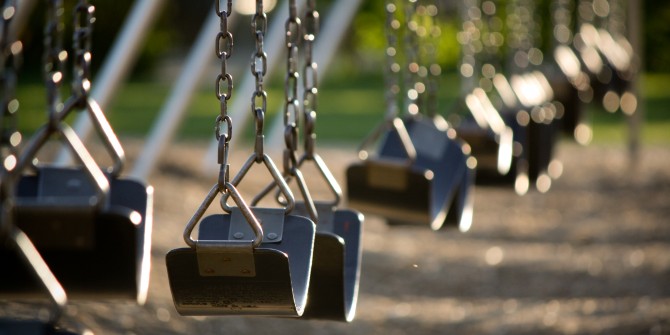Dublin has outperformed even best-case scenarios for COVID-19 mortality among homeless and drug-using populations, write Austin O’Carroll, Tony Duffin and John Collins (LSE). When government policy is well coordinated and underpinned by a science-driven and fundamentally pragmatic approach, lives are saved.
When the COVID-19 pandemic reached Dublin, homeless people were identified as a particularly vulnerable group due to their morbidity profile, living conditions and drug use behaviour. At the outset of the policy response there was a very clear sense of what client groups were being targeted: people who are homeless, and who use drugs in Dublin city centre, an area with the highest population of these clients. Very early on, the Health Service Executive appointed a Clinical Lead for the COVID-19 Homeless Response. Accommodation to allow isolation of positive and suspected cases was rapidly obtained, and staff were funded by the HSE. Homeless clients who were deemed vulnerable due to age or medical condition were moved to single occupancy accommodation so that they could be shielded from infection. In addition, homeless accommodation with large numbers of residents saw many transferred in order to decrease occupancy levels and thereby to reduce the risk of spreading COVID-19. By early June:
• over 750 clients had been tested;
• over 330 clients had been placed in isolation;
• over 500 people had been placed in shielding, of whom 340 were shielded in newly
obtained units;
• 120 people were moved from high occupancy units to new reduced-occupancy
accommodation;
• all rough sleepers were offered accommodation.
The result was that COVID-19 infection and mortality rates were very low with only 63 homeless people diagnosed. There was only one COVID-19-related death, a fraction of what had been predicted). The expansion of housing provision was an unequivocal success in limiting the direct effects of COVID-19 transmission and infection.

In Dublin there are two main routes for homeless clients to access Opioid Substitution Therapy (OST). First, the National Drug Treatment Centre (NDTC), which is a designated OST service for homeless people from across Ireland. The NDTC is based in Dublin city centre and is the largest treatment centre in the Republic. Prior to the COVID-19 crisis the NDTC had about 550 clients, with methadone being dispensed on site. Second, GMQ Medical, which was established as a primary care service for homeless people based out of day services.
Before the crisis, GMQ Medical had about 150 clients. However, there was a cap on the numbers of patients/hostels it could recruit and NDTC had capacity issues. Due to the large increase in the homeless population in Ireland since the 2007 recession, there has been an
imbalance between numbers applying for treatment and those actually being transferred
to the community. This resulted in a waiting time for treatment for GMQ Medical of
between 12-14 weeks.
It was quickly recognised that one of the main deterrents to individual compliance with
isolation and shielding guidelines was substance use, particularly heroin. Immediately, the HSE issued national contingency guidelines allowing for reduced waiting times and removal of caps on recruitment to treatment. In addition, other drug treatment clinics agreed to take on homeless patients resident in hostels in their catchment areas. Waiting times dropped overnight from 12-14 weeks to 2-3 days. An inpatient unit for rapid initiation on to OST for COVID-19 positive, and suspected, patients was established. Supervision guidelines were amended to allow members of the NDTC and two other services to collect clients’ OST and other medication and deliver it at intervals dictated by the client’s risk of overdose.
In Dublin, 62% of homeless people on OST also misuse street benzodiazepines (BZD). Before the pandemic, GMQ Medical offered BZD detoxes based on the national protocol, but only offered BZD maintenance in occasional cases where previous detoxes had failed and the client was seen to be at high risk from substance misuse. As COVID-19 infections started to rise in Dublin and clients were placed in Isolation Units and Shielding Units, it was realised that those with high dose BZD dependence were unlikely to remain in their accommodation so increasing their, and other residents’, risk of infection. National contingency guidelines emerged recommending that patients in isolation could be offered up to 30mg daily to prevent withdrawals for the period of isolation only.
At the homeless health sector’s weekly meetings, it was noted that the health and behaviour of clients on maintenance had seemed to improve and that they had complied with the isolation/shielding recommendations. As a result, GMQ Medical decided to offer BZD maintenance treatment to all patients on OST with established BZD dependency.
Naloxone is an opioid antagonist recommended by the WHO for the treatment of opioid
overdose. In Ireland there are relatively restrictive pathways for accessing Naloxone. Recognising the increased risk of overdose during the COVID-19 crisis, the process for accessing Naloxone was quickly adapted those most at risk. Naloxone packs were taken out by Ana Liffey Drug Project when delivering their Needle and Syringe Programme (NSP). A person engaging with the outreach NSP was assessed by Ana Liffey Drug Project, who briefed them and/or their partner/companion on the process of using Naloxone and gave them the drug. The names and date of birth were later provided to a GP who issued the prescription for Naloxone retrospectively.
On 26 March 2020, the HSE published new guidance on Naloxone, recommending that every individual in receipt of OST and in contact with treatment providers should be offered and encouraged to take a supply of Naloxone.
Before COVID-19, all of these policy choices were limited by regulatory obstacles and uncertain political will. The response to the pandemic has demonstrated some of the unnecessary obstacles placed ahead of potentially lifesaving treatments. Furthermore, it has only served to reiterate the value and logic of harm reduction-based drug policies.
Why did these barriers exist prior to the crisis? The epidemic created an overwhelming public health argument for the facilitation of immediate access to OST and Naloxone. However, there was already a strong public health argument for having no waiting lists for OST and improved Naloxone distribution to people who use drugs.
In Irish medicine, the COVID-19 crisis facilitated a number of practice changes that had persuasive arguments in their favour prior to COVID-19 (e.g. emailed prescriptions, electronic social welfare certificates, teleconsultations etc.) Why it took a pandemic to overcome barriers to seemingly obvious practice reforms is difficult to discern. Possibilities include the effect of the fear and uncertainty that was palpable as COVID-19 infection spread across the nation; the unification of the health service with a clear single mission to reduce the transmission of infection; or more controversially, the fact that the public health arguments in favour of harm reduction related mainly to the protection of people who use drugs, whereas the public health arguments that arose during the COVID-19 crisis related to protecting the public at large.
The COVID-19 crisis acted as a catalyst for changes in the delivery of harm
reduction measures to homeless people who use drugs. We recommend that practices continue to deliver on OST and Naloxone policy objectives and that policy makers review the evidence on BZD maintenance treatment. We further encourage international jurisdictions to see if Dublin’s experience holds any lessons relevant for their immediate efforts to reduce COVID-19 transmission and save lives. We view the COVID-19 experience as a potentially important milestone in the development of national drug policies.
This post represents the views of the authors and not those of the COVID-19 blog, nor LSE. It is an edited extract from Saving Lives in the Time of COVID-19: Case Study of Harm Reduction, Homelessness and Drug Use in Dublin, Ireland.





Great scalable model!
Wasnt this a bit premature taking credit for something that didnt happen, in fact we have seen the highest number ever of homeless dearhs in Dublin in one month July 2020, perhaps you guys should spend some realtime in the realworld, not just books, conferences and flying visits to the trenches.
https://www.google.com/amp/s/www.irishexaminer.com/news/arid-40029146.html%3ftype=amp